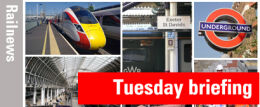Posted 25th October 2022 | 3 Comments
New open access operator celebrates shift to rail

Open access operator Lumo, which is owned by FirstGroup and runs between Edinburgh and London, said the number of people travelling by rail on the route has increased to 57 per cent of the rail-air market, compared with 35 per cent before the Covid pandemic. Lumo started running on 25 October 2021 and introduced its full timetable in April. The operator also said it is looking forward to welcoming its millionth passenger in November.
First Class 387 electric unit to get ETCS
Govia Thameslink Railway has sent a Class 387 Electrostar unit from London to Worksop, so that it can be fitted with in-cab signalling by Alstom. The work marks the begnning of the conversion of the fleet for operation on the southern section of the East Coast Main Line, which is to be converted to ETCS. It will also lay the foundations for a similar upgrade of the wider Electrostar fleets. The train will be tested at Litchurch Lane in Derby before it is moved to Network Rail’s RIDC Melton test track, where it will be able to run at the 387s’ maximum speed of 110mph (177km/h).
Reader Comments:
Views expressed in submitted comments are that of the author, and not necessarily shared by Railnews.

John Helm, CHATHAM
It would be interesting to get a fuller breakdown of the results. IE What percentage are likely to be day return travellers? I wouldn’t have thought it could be that much given that journey times are still around 4.5 hours both ways, which as well as being tiring doesn’t leave much time to spend at the destination for day trippers.
Back in the 1960s BR market research found that three hours was the maximum time passengers were prepared to spend on a train. Makes sense. Three hours both ways still leaves plenty of time to spare. That’s why the LMR Euston-Manchester/Liverpool electrification was so successful whereas the Euston-Glasgow was not.
david C Smith, Bletchley
I understand that most of Lumo's passengers are won from aviation, not from LNER, so their existence in their chosen form would seem to largely add to rail's share of Edinburgh to London passengers.
On the continent, there seem to be similar innovations with similar results: "Ouigo" in France and "Flixtrain" in Germany , giving travellers a wider choice.
david C Smith, Bletchley
This initial success for Lumo indicates the notion of "horses for courses", with specialised provision for particular market sectors as a way forward for the future.
{Or cherry-picking the market and fragmenting the railway at the same time? To be fair to Lumo, they did not claim that the shift is solely due to them. LNER runs many more trains to Edinburgh each day.--Ed.)